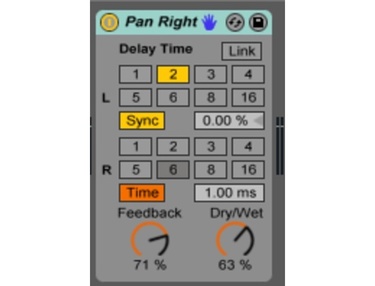
This will control the speed of the pitch modulation and ranges from. Moving from left to right, you first have the option to set the Rate of the LFO. Let’s take a look at the parameters available in the Chorus option of Nectar Pro’s Dimension module: Usually choruses use delay times of 15–35 ms. For the most part, a slower speed/rate will generate a subtle chorusing effect while a faster speed/rate will cause more phase-shifting and perceived pitch modulations of the original signal.Ĭhoruses use much longer delay times than those of flangers, resulting in a sound that doesn't sound like a comb filter as much as it sounds a bit like two signals overlaid. Furthermore, the longer delay times compared to those of phasers and flangers result in gradual changes in the frequency of the final signal which creates variations in the copy’s pitch. The timing differences cause a constantly changing phase-shift between the original signal and the duplicated signal(s). Rather than using a pitch circuit to modulate pitch, like a vibrato effect, a chorus achieves subtle changes in pitch by modulating the delay time of the waveform with a low frequency oscillator (LFO). You get a ‘chorusing’ effect by creating a copy (or multiple copies) of a signal, varying its period (pitch), and then mixing the modulated copies with the original signal. We can describe the sound of “chorusing” as a doubling effect that adds thickness, shimmer, and helps a signal sound “larger” than it would on its own. “Chorusing” is meant to simulate the subtle pitch and timing differences that occur when multiple musicians or vocalists play the same note, but vary slightly in pitch and timing. The chorus effect is by far one of the most popular phase modulation effects used in music. When two waveforms are perfectly out-of-phase (technically called reverse polarity), on the other hand, it means one waveform’s peak (highest point) is being displaced, or canceled by another waveform's troughs (lowest point). The end result is constructive interference: the identical waveforms will add together to produce an amplitude equal to the sum of the individual waveforms (+6 dB of gain on a meter). Think of when you record a track and then you duplicate it without making any changes to differentiate them from one another. When two waveforms are in-phase, it means that they are perfectly aligned in time, and have a wave difference of 0. Two important phase relationships to keep in mind are those that result in constructive (in-phase) and destructive (out-of-phase) interference which are more likely to occur when identical waves are stacked together, as is the case with chorus, flangers, and phasers. It’s these phase relationships between waves that causes the unique sonic qualities created by chorus, flangers, and phaser effects. When speaking of the phase relationship between similar waveforms, we can say that waves are either in-phase, out-of-phase, or anything in between. We'll go over each modulation effect in greater detail below so continue reading. Chorusing uses a longer delay time than a flanger effect while a phaser uses an all pass filter to generate the desired effect without using delays at all. Simply put, delay time is what differentiates chorus effects, flanger effects and phaser effects. These processors are all related, and are often confused with each other, but they have notable differences that are worth pointing out. While there are lots of unique-sounding audio effects for sound design, there are a few you’re likely to come across time and time again: chorus, flangers, and phasers.

In a creative or sound design focus, however, we can take advantage of more specialized processors to create interesting sounds. In a mixing context, these are the most important plug-ins you’ll be dealing with. These can be (and often are) used in every project, being the main tools in a producer’s arsenal. Most producers are familiar with the most common audio processors: EQs, compressors, reverb, and delay.


 0 kommentar(er)
0 kommentar(er)
